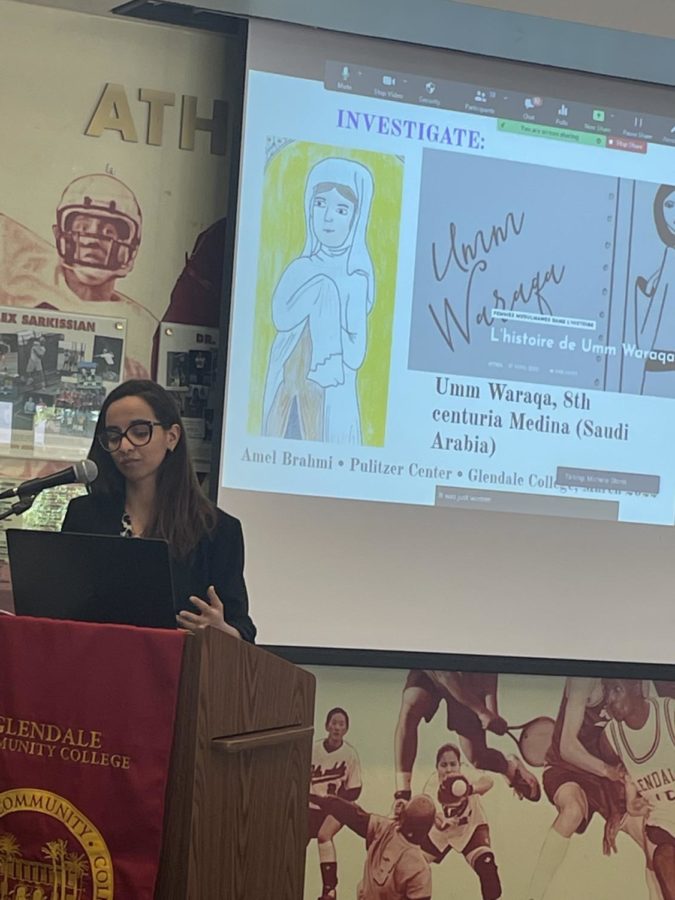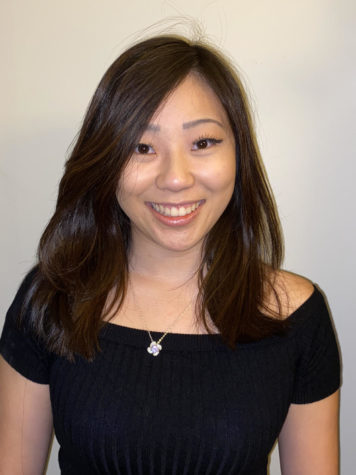GCC Pulitzer Center Hosts Reporting Fellow Amel Brahmi
Event highlights the advancement of female imams and the challenges they face
On March 22, the GCC Pulitzer Center hosted an event featuring journalist Amel Brahmi about the progression of Muslim women as imamats in Los Angeles as part of the Humanities and Social Sciences Lecture series celebrating Women’s History Month.
During this hyflex event, Brahmi discussed the story that she reported about women imams, religious leaders in mosques, and the challenges that they face. Brahmi explained how women and men are typically separated when being in a congregation. While men are able to lead the congregation, women are forbidden from leading mixed congregations composed of both men and women. “If you go to a local mosque here in Los Angeles, you’ll see there is a room for women and a room for men. Sometimes, in some places in America the room for women is in a different building,” said Brahmi.
As part of her reporting, Brahmi visited the only women’s mosque in the United States, which was founded in 2015, for their 5th Year Anniversary. “I had never been in a mosque where women were leading the congregation … I was very impressed by the ways they were leading congregations,” said Brahmi. Located in Koreatown, it was during this event that Brahmi watched the main character for her story, a female imam named Tasneem Noor, lead a prayer. Noor worked in student affairs at UCLA at the time, and she had decided to dedicate her life to her religion. Brahmi explains that Noor found her place in LA’s women’s mosque. “The story is about how she’s struggling to find and express her religious identity in a faith dominated by men…,” said Brahmi. Brahmi also describes how when Noor would lead prayers, women would pray four to five extra times in an effort to “make up” for the prayer Noor led because they were not sure about whether the prayer was legitimate.
Brahmi further provided some background knowledge about Islam during the event. “Sunna are rules and customs …that were in place during the life of the Prophet,” said the journalist. Hadiths are “every little story that we’re told by people who lived at the time of the Prophet. And so they repeated those stories to people and those stories were written down. And they were written down as this is what the Prophet said,” she further explained. “There is a lot of discussion about the accuracy of the quotes and the meaning of the quotes.”
During her presentation, she introduced another female imam named Amina Wadud, also known as the Lady Imam. In 2005, Wadud broke tradition and led a mixed prayer, meaning that she led a congregation of both women and men. “She wasn’t the first one to say … the religion and scriptures are being instrumentalized in order to keep women as second-class citizens. But she’s the first one who said the Quran is not gendered and … that God wasn’t talking to men, he was talking to everyone,” explained Brahmi.
Curious about how female imams fit into the religion, Brahmi interviewed the Islamic Society of North America. She learned that “Women can lead women, they just can’t lead men. … If the woman is in the front, then they are facing her rear, and it is considered as not appropriate.”
Brahmi also talked about a widow named Umm Waraqah who was a companion of the Prophet. Brahmi explained that Umm Waraqah told the Prophet Mohammed that she wanted to go to the battlefield with him. However, he said that she should stay because she was the first “woman to have memorized the holy words in the Quran by heart. So she was the only one who could lead the prayers in his absence,” said Brahmi. She further described the debate about some of the details of the story including who was in the congregation that Umm Waraqah led and how she came to lead the congregation. At the end of the hadith, Umm Waraqah is killed by her two servants. “I remember reading a comment by a scholar on that, and she said something that stayed with me. She said, ‘Was it there in the hadith as a warning for any other women that wanted to lead prayers in the future,’” said Brahmi.
In trying to understand why more women do not try to become imams, Brahmi learned from Noor that for most women, the idea of even being an imam was not viewed as a possibility for them. “And so the reason why Tasneem cannot be an imam and why many women don’t know it’s even possible is because it was never in [their] horizons,” expressed Brahmi.
In closing the presentation, Brahmi expressed her hopes that the women’s mosque in Los Angeles will reopen to serve the community. “In that mosque, they talk about a lot of things like miscarriages, sexual assaults, things you cannot talk with a male imam about as freely,” said Brahmi. She hopes that LA’s women’s mosque will continue to help broaden women’s horizons and show them more possibilities as Noor has found.
To learn more about the topics discussed, visit: https://www.theguardian.com/global/2021/nov/22/female-imam-california-mosque
To learn more about GCC’s Pulitzer Center please visit: https://www.glendale.edu/academics/academic-divisions/social-sciences-division/history/pulitzer-center-campus-consortium
Jacqueline Kamei can be reached at [email protected]
Frida Villanueva can be reached at [email protected].
Valerie Valdiviezo can be reached at [email protected].


